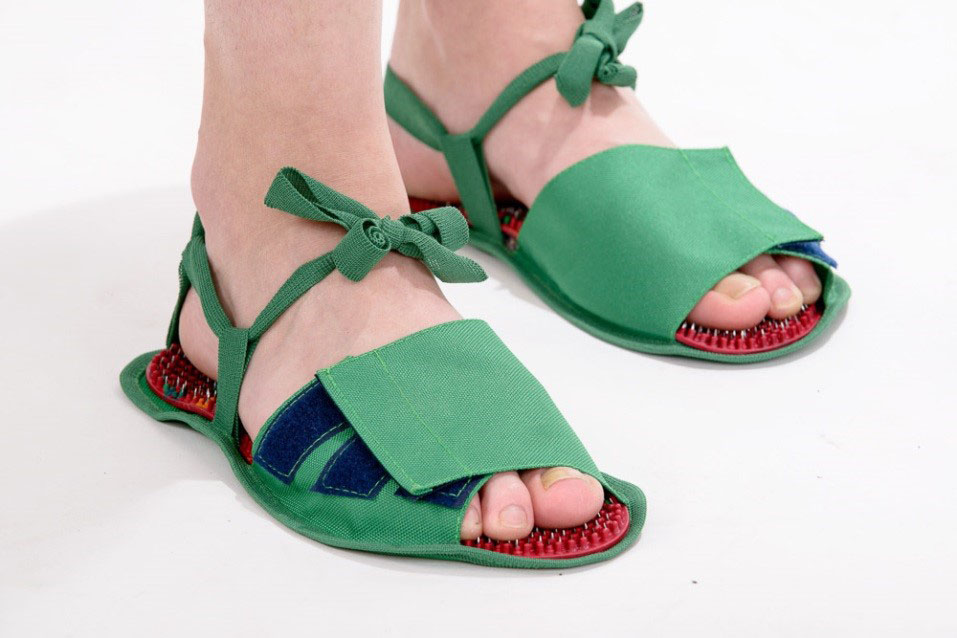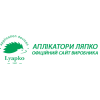Treatment and prevention of scoliosis with application devices Lyapko
What is scoliosis
Scoliosis is a curvature of the spinal column. Moreover, not any curvature, namely the lateral deviation of the vertical axis of the spine. The fact is that normally our spine is not perfectly even. The bends present in the anterior and posterior direction (lordosis and kyphosis) protect it from excessive loads while maintaining the body in a certain position. Negative processes in the body develop only in cases where these bends are expressed in excess of the permissible norm.
Often the cause of scoliosis is congenital disorders of the connective tissue of the vertebrae or other skeletal disorders, as well as injuries, pathology of the nervous system.
Not the last role in the development of scoliosis is played by an unbalanced diet with a low content of calcium salts, an excessive passion for carbonated drinks, carbon dioxide and phosphoric acid, which contribute to the leaching of calcium salts from bone tissue.
The disease is aggravated by an unhealthy lifestyle.
The development of the disease begins gradually and imperceptibly. Pain in the spine appear already when scoliosis enters the active phase of the disease. They occur during exercise and decrease or disappear completely after rest or at rest.
Without proper treatment, scoliosis gradually progresses. With the development of a severe degree of the disease, patients may experience disturbances in the functioning of internal organs, various problems with the nervous system.
Often scoliosis "pulls" other deviations in the body, such as:
- chest deformity;
- osteochondrosis;
- changes in the pelvic bones;
- muscle asymmetry;
- displacement of the heart, blood vessels, internal organs;
- compression of the lung;
- flat feet;
- change in the position of the spinal cord, etc.
Ultimately, a very complex deformity of the spine and the whole body occurs.
Scoliosis diagnosis
To detect spinal deformity, a simple visual examination is often sufficient. Attention is drawn to the visible curvature of the contours of the spine, the asymmetry of the shoulder girdle, the angles of the shoulder blades, the secondary curvature of the pelvis and the shortening of the lower limb on the side of the curvature.
In the presence of at least one of these signs, an X-ray of the spinal column, magnetic resonance imaging (MRI) is shown, during which a three-dimensional image of the spine can be obtained on the monitor screen. With significant curvature, it is necessary to investigate the work of internal organs - to conduct spirometry, electrocardiography, ultrasound of the heart and internal organs.
Depending on the age of onset of the deformity, the following groups of scoliosis are distinguished:
- Infantile (diagnosed before 3 years) (Infantile)
- Juvenile (diagnosed from 3 to 10 years old) (Juvenile)
- Juvenile (teenage) (diagnosed from 10 to 15 years old) (Adolescent)
- Scoliosis in adults (diagnosed in adulthood, after cessation of growth) (Adult)
In adults, the main cause of scoliosis is degenerative-dystrophic changes in the spine.
Depending on the location of the deformity, scoliosis can be:
- chest
- thoracolumbar
- lumbar
- combined S-shaped
There are 4 degrees of scoliosis:
Scoliosis 1 degree - the angle of curvature does not exceed 10 degrees. Asymmetry is almost invisible to the eye. The stoop, uneven level of the shoulder girdle is noteworthy.
Scoliosis 2 degrees - the angle of curvature is from 11 to 25 degrees. To this extent, torsion (rotation) of the vertebrae is already noted. There is visible asymmetry of the shoulder girdle and pelvis. Due to pathological muscle tension, a muscle roller is formed in the lumbar region from the concave side, and in the chest region - from the convex side.
Scoliosis 3 degrees - the curvature ranges from 25 to 50 degrees. Visible deformation of the chest - retraction of the intercostal spaces from the concave side of the curvature and bulging from the convex. Weakening of the abdominal press, the formation of a hump.
Scoliosis 4 degrees - the angle of curvature I exceeds 50 degrees. Expressed cosmetic defect and all previous signs. Low tolerance for even small physical exertion. In addition to the musculoskeletal system, internal organs suffer.
The first and second degrees, before the end of the formation of the skeleton in a teenager, can be corrected with the help of physical exercises.
If a person has a third or fourth degree of scoliosis, the therapeutic process is much more complicated and lengthy.
At the same time, it should be taken into account that the final formation of the spine is completed by the age of 20, and after the onset of the so-called skeletal maturity, correction of the curvature is practically impossible. However, in this case, the diagnosis of "scoliosis" is not the final verdict.
Scoliosis treatment
Treatment of scoliosis can be carried out both conservatively and surgically. Conservative methods include drug treatment, massage, physiotherapy, manual therapy, etc.
Medications (chondroprotectors, vitamins, restorative drugs) play only an auxiliary role in the treatment of scoliosis. It is possible to strengthen muscles, eliminate the muscle roller, and even to a large extent stabilize the spine with the help of massage and manual therapy. A good effect is given by physiotherapy exercises. But here, with inadequate physical exertion, spinal instability increases and scoliosis progresses. With a high degree of scoliosis, running, strength exercises, jumping, and outdoor games are contraindicated.
When the first signs of scoliosis appear, it is recommended to start swimming. This sport well relieves tension from the spine, gently stretching it, develops the muscles of the shoulder girdle and legs, makes the back muscles work in various modes without overloading them. After each session in the pool, it is good to have a massage or a short time in the sauna.
With a curvature of the spine, any physical activity is welcome, but in no case should it be excessive. The main goal of scoliosis treatment is to strengthen the back muscles and restore the symmetry of their structure.
In parallel, it is necessary to monitor the work of the nervous system, internal organs.
Treatment of scoliosis in children
When treating scoliosis in a child, it is necessary to reduce the excessive load on the spine, while at the same time strengthening the muscles of the back and the entire body.
Recommended:
- sleep on a hard bed, use an orthopedic mattress;
- go to school only with a satchel;
- choose a chair and table suitable for the child for homework (furniture should be physiological and comfortable, correspond to the height of the child);
- develop internal self-discipline in the child, he must learn to independently monitor his posture;
- daily exercise therapy;
- it is desirable to undergo a course of treatment in a specialized sanatorium.
A child with scoliosis needs a healthy, balanced diet. You should include in the diet a vitamin-mineral complex with such essential elements as: calcium, phosphorus, magnesium, sodium, potassium, vitamin D, a group of vitamins B.
A contrast shower is useful (this is a tonic procedure for the vessels and muscles of the whole body).
Passive smoking is unacceptable (since nicotine causes constriction of capillaries and blood vessels, which worsens the blood supply to the muscular-ligamentous apparatus).
A very good result is given by position correction - an optimal posture is created that contributes to the normalization of posture.
With 2 degrees of scoliosis, it is recommended to wear a special orthopedic corset. It is made individually in orthopedic workshops at specialized orthopedic centers. It is recommended to wear a corset constantly, at least 16 hours a day (preferably all 24 hours), removing it only for hygiene procedures.
Taking into account all the features and stage of the disease, therapeutic and health-improving sessions of physiotherapy exercises are recommended.
A set of exercises is developed for each patient individually, taking into account the localization and severity of the curvature:
- applied kinesiology;
- osteopathy;
- manual therapy (soft techniques);
- medical massage;
- acupuncture, application therapy Lyapko.
Scoliosis treatment with Lyapko application devices
Especially qualitatively and quite quickly, excellent results can be achieved in the complex treatment of scoliosis with the help of Lyapko's application devices, which are among the means of physiotherapy treatment.
The action of the applicators is based on the principles of traditional Chinese medicine - superficial multi-needle acupuncture, as well as on the general physiological mechanisms of life. More detailed information can be obtained in the article "Lyapko applicators - mechanisms of action and application zones".
Their use simultaneously has the effect of several procedures: massage, electrophoresis and acupuncture. It allows you to reduce the number of drugs, and the correction of posture proceeds much faster.
Application therapy has a pronounced analgesic and antispasmodic effect. Improves blood circulation, lymph flow, microcirculation, reduces tissue swelling.
Lyapko's application devices allow you to simply and quickly achieve an improvement in blood supply in the application area, while removing muscle spasm, and, consequently, reducing pain in muscles, joints, and in the region of internal organs. The aching back pain that inevitably accompanies this disease disappears.
Also, UAL normalizes sleep, the work of the cardiovascular, nervous system.
Since scoliosis is a chronic and progressive disease, Lyapko application devices should be used in courses throughout life.
In the presence of scoliosis, application therapy will help improve the condition of the muscles, some of which are overstretched, and some are spasmodic. This makes it possible to correct different muscle loads on the spine.
To do this, in the first half of the day, you need to work with a roller “Large Roller M” or “Universal Roller M” along the spine on one side and the other alternately, 2-3 times a day.
You need to start the procedure from the side of the lowered shoulder, this indicates that the muscles there are tense, spasmodic and need to be relaxed. To do this, roll with a roller easily for 10-15 minutes along the entire length of the back.
Then we move to the opposite side of the back, where the muscles are overstretched - they need to be toned. On this side, we work with a roller for 3-5-7 minutes.
“Procedures should be taken in courses of 10-14 days with a break of 2-4 weeks. A more frequent use of UAL also has a good effect.
It is necessary to act on the muscles of the back and chest in front.
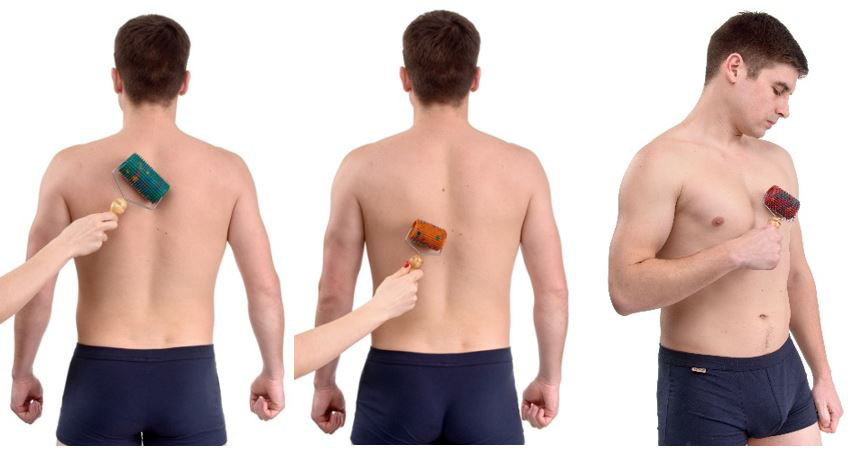
In the afternoon, before going to bed, it is better to apply both a manual back massage and massage using the Pharaoh massager, which can be worked through a thin fabric. Long, up to 15 min. and more, massage contributes to the complete relaxation of muscles, creates a sedative (calming) effect.
During the session, you should perform circular movements clockwise or longitudinal - up and down.

After the massage, we recommend laying on a flat applicator for rest and relaxation.
The step of the applicator is selected depending on the individual skin sensitivity and the age of the patient.
They lie on the applicators with their backs - they can be applied to the spine itself. It is important to position the patient correctly, taking into account the areas of curvature, so that there is an even contact with the needles for a comfortable feeling.
Application areas: the entire area of the neck, back, lumbosacral. The larger the area of influence, the better the therapeutic effect. It is recommended to use large flat applicators. For better relaxation of the spine under the hips, you can additionally put small pillows. The duration of exposure is 20-40 minutes in the evening before going to bed.
In the application area, blood circulation is improved, the pores are “opened”, the application of anti-inflammatory, anesthetic creams, ointments contributes to their better penetration into the skin, subcutaneous tissue, muscles and enhance their action.
If the procedure is carried out in the daytime, then bed rest is indicated for 1–2 hours in order to reduce the “weight load” on the spine. The vertical position immediately after treatment increases the load on the spine due to its own weight and reduces the effect of the procedure.
It is recommended to use large-sized flat applicators on the back area: Applicator "Large mat", "Massage needle large mat", "Chance 6.2x4", "Folk", "Chamomile M", "Quadro".

It is also possible to use smaller flat applicators: “Needle massage pillow”, “Insoles plus”, “Chance”, “Sputnik plus”, which are placed on the pain area.
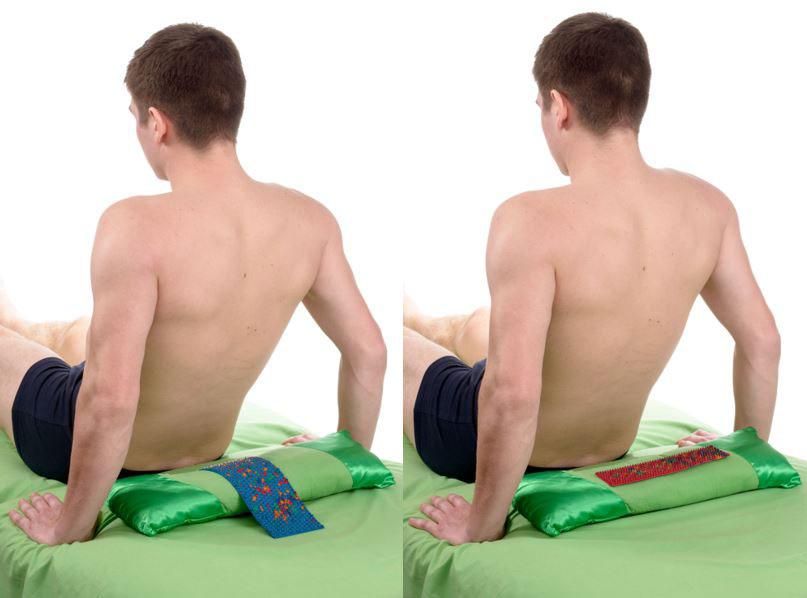
In addition to the back area, to enhance the effect, it is recommended to use applicators on auxiliary zones on the front surface of the body, in the area of pain projection.
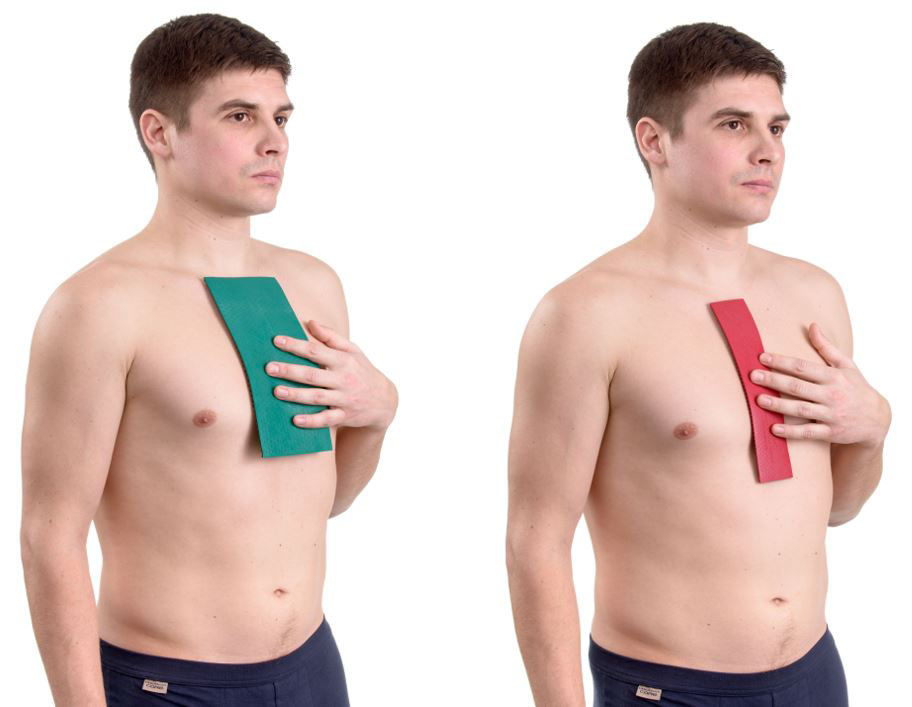
The exposure time is 20–30 minutes, the course of treatment is 10–14 days, which can be repeated after a break in 1–2 weeks. Such procedures can be applied in courses for a long time.
In case of severe pain syndrome, the "Kid" belt, the "Universal M" belt is fixed across or along the spine to the pain zones for 20-40 minutes.
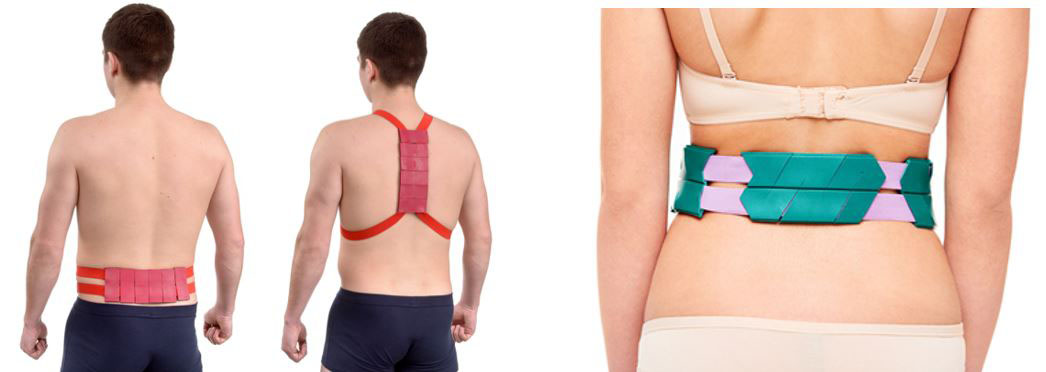
You can also wrap the pain zone with the “Health Magic Tape”, which simultaneously affects the main and auxiliary zones.
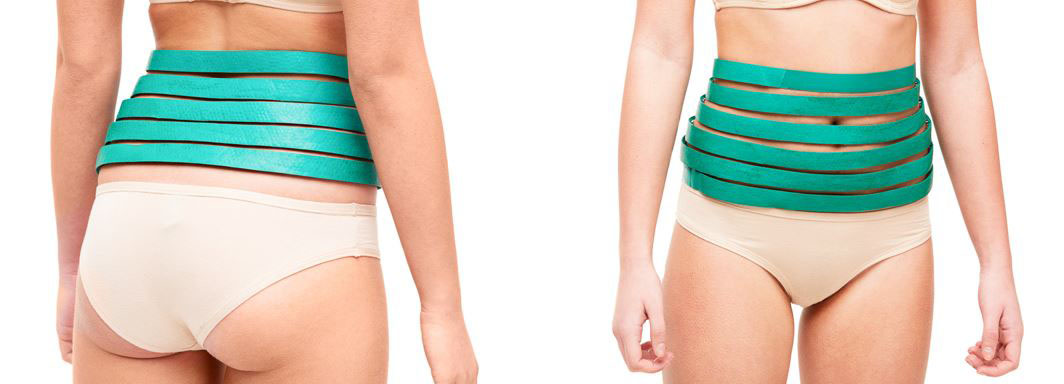
It is better to end the session by influencing the feet using the Insole Plus applicator. Feet are a reflection of our body. In the presence of flat feet, posture changes, there is a load on the spine and all this can lead to scoliosis. Experienced massage therapists and chiropractors always begin treatment of the spine with massage and foot correction. More detailed information can be obtained in the article "The foot is a special reflexogenic zone of our body"
